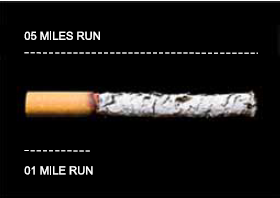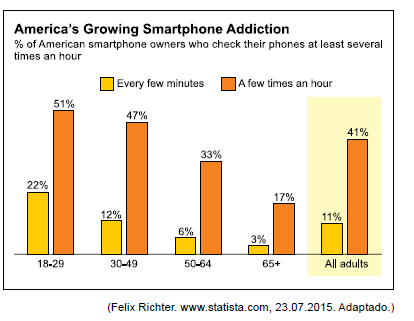Questões de Vestibular
Comentadas sobre interpretação de texto | reading comprehension em inglês
Foram encontradas 680 questões

• A imagem permite inferir que:

• Assinale a alternativa que corresponde à informação contida no texto
Look at the pictures of the advertising campaign created by Fosbury&Brothers.


The purpose of the campaign is to show that smoking
Observe the image.

(www.michaelkonik.com, 05.10.2013.)
The art print overlaps
What does love look like? Love is accepting that your partner is not perfect, but you want to be with him or her anyway. Love is being grateful that you are accepted despite your imperfections. Love is still being happy to come home to that same person, even after 30 years.
What does love look like? Love is accepting that your partner is not perfect, but you want to be with him or her anyway. Love is being grateful that you are accepted despite your imperfections. Love is still being happy to come home to that same person, even after 30 years.
The Mona Lisa was recently moved from her usual gallery in the Salle des États, currently being renovated, to a temporary home in the Galérie Médicis. Visitors to the Louvre who have queued patiently for hours are complaining that museum staff are allowing them less than a minute to view the masterpice. The relocation has created bottlenecks of visitors lining corridors and the Louvre is now advising that only those who have pre-booked will be guaranteed a glimpse of the world’s most famous portrait.
The Mona Lisa was recently moved from her usual gallery in the Salle des États, currently being renovated, to a temporary home in the Galérie Médicis. Visitors to the Louvre who have queued patiently for hours are complaining that museum staff are allowing them less than a minute to view the masterpice. The relocation has created bottlenecks of visitors lining corridors and the Louvre is now advising that only those who have pre-booked will be guaranteed a glimpse of the world’s most famous portrait.
Leia o infográfico para responder à questão.

Leia o infográfico para responder à questão.

Leia o infográfico para responder à questão.

Leia o infográfico para responder à questão.

Leia o infográfico para responder à questão.

Wood wide web: trees’ social networks are mapped
Research has shown that beneath every forest and wood there is a complex underground web of roots, fungi and bacteria helping to connect trees and plants to one another. This subterranean social network, nearly 500 million years old, has become known as the “wood wide web”. Now, an international study has produced the first global map of the “mycorrhizal fungi networks” dominating this secretive world.
Using machine-learning, researchers from the Crowther Lab at ETH Zurich, Switzerland, and Stanford University in the US used the database of the Global Forest Initiative, which covers 1.2 million forest tree plots with 28,000 species, from more than 70 countries. Using millions of direct observations of trees and their symbiotic associations on the ground, the researchers could build models from the bottom up to visualise these fungal networks for the first time. Prof Thomas Crowther, one of the authors of the report, told the BBC, “It’s the first time that we’ve been able to understand the world beneath our feet, but at a global scale.”
The research reveals how important mycorrhizal networks are to limiting climate change — and how vulnerable they are to the effects of it. “Just like an Magnetic Resonance Imaging scan of the brain helps us to understand how the brain works, this global map of the fungi beneath the soil helps us to understand how global ecosystems work,” said Prof Crowther. “What we find is that certain types of microorganisms live in certain parts of the world, and by understanding that we can figure out how to restore different types of ecosystems and also how the climate is changing.” Losing chunks of the wood wide web could well increase “the feedback loop of warming temperatures and carbon emissions.”
Mycorrhizal fungi are those that form a symbiotic relationship with plants. There are two main groups of mycorrhizal fungi: arbuscular fungi (AM) that penetrate the host’s roots, and ectomycorrhizal fungi (EM) which surround the tree’s roots without penetrating them.
(Claire Marshall. www.bbc.com, 15.05.2019. Adaptado.)
Wood wide web: trees’ social networks are mapped
Research has shown that beneath every forest and wood there is a complex underground web of roots, fungi and bacteria helping to connect trees and plants to one another. This subterranean social network, nearly 500 million years old, has become known as the “wood wide web”. Now, an international study has produced the first global map of the “mycorrhizal fungi networks” dominating this secretive world.
Using machine-learning, researchers from the Crowther Lab at ETH Zurich, Switzerland, and Stanford University in the US used the database of the Global Forest Initiative, which covers 1.2 million forest tree plots with 28,000 species, from more than 70 countries. Using millions of direct observations of trees and their symbiotic associations on the ground, the researchers could build models from the bottom up to visualise these fungal networks for the first time. Prof Thomas Crowther, one of the authors of the report, told the BBC, “It’s the first time that we’ve been able to understand the world beneath our feet, but at a global scale.”
The research reveals how important mycorrhizal networks are to limiting climate change — and how vulnerable they are to the effects of it. “Just like an Magnetic Resonance Imaging scan of the brain helps us to understand how the brain works, this global map of the fungi beneath the soil helps us to understand how global ecosystems work,” said Prof Crowther. “What we find is that certain types of microorganisms live in certain parts of the world, and by understanding that we can figure out how to restore different types of ecosystems and also how the climate is changing.” Losing chunks of the wood wide web could well increase “the feedback loop of warming temperatures and carbon emissions.”
Mycorrhizal fungi are those that form a symbiotic relationship with plants. There are two main groups of mycorrhizal fungi: arbuscular fungi (AM) that penetrate the host’s roots, and ectomycorrhizal fungi (EM) which surround the tree’s roots without penetrating them.
(Claire Marshall. www.bbc.com, 15.05.2019. Adaptado.)
Wood wide web: trees’ social networks are mapped
Research has shown that beneath every forest and wood there is a complex underground web of roots, fungi and bacteria helping to connect trees and plants to one another. This subterranean social network, nearly 500 million years old, has become known as the “wood wide web”. Now, an international study has produced the first global map of the “mycorrhizal fungi networks” dominating this secretive world.
Using machine-learning, researchers from the Crowther Lab at ETH Zurich, Switzerland, and Stanford University in the US used the database of the Global Forest Initiative, which covers 1.2 million forest tree plots with 28,000 species, from more than 70 countries. Using millions of direct observations of trees and their symbiotic associations on the ground, the researchers could build models from the bottom up to visualise these fungal networks for the first time. Prof Thomas Crowther, one of the authors of the report, told the BBC, “It’s the first time that we’ve been able to understand the world beneath our feet, but at a global scale.”
The research reveals how important mycorrhizal networks are to limiting climate change — and how vulnerable they are to the effects of it. “Just like an Magnetic Resonance Imaging scan of the brain helps us to understand how the brain works, this global map of the fungi beneath the soil helps us to understand how global ecosystems work,” said Prof Crowther. “What we find is that certain types of microorganisms live in certain parts of the world, and by understanding that we can figure out how to restore different types of ecosystems and also how the climate is changing.” Losing chunks of the wood wide web could well increase “the feedback loop of warming temperatures and carbon emissions.”
Mycorrhizal fungi are those that form a symbiotic relationship with plants. There are two main groups of mycorrhizal fungi: arbuscular fungi (AM) that penetrate the host’s roots, and ectomycorrhizal fungi (EM) which surround the tree’s roots without penetrating them.
(Claire Marshall. www.bbc.com, 15.05.2019. Adaptado.)
Wood wide web: trees’ social networks are mapped
Research has shown that beneath every forest and wood there is a complex underground web of roots, fungi and bacteria helping to connect trees and plants to one another. This subterranean social network, nearly 500 million years old, has become known as the “wood wide web”. Now, an international study has produced the first global map of the “mycorrhizal fungi networks” dominating this secretive world.
Using machine-learning, researchers from the Crowther Lab at ETH Zurich, Switzerland, and Stanford University in the US used the database of the Global Forest Initiative, which covers 1.2 million forest tree plots with 28,000 species, from more than 70 countries. Using millions of direct observations of trees and their symbiotic associations on the ground, the researchers could build models from the bottom up to visualise these fungal networks for the first time. Prof Thomas Crowther, one of the authors of the report, told the BBC, “It’s the first time that we’ve been able to understand the world beneath our feet, but at a global scale.”
The research reveals how important mycorrhizal networks are to limiting climate change — and how vulnerable they are to the effects of it. “Just like an Magnetic Resonance Imaging scan of the brain helps us to understand how the brain works, this global map of the fungi beneath the soil helps us to understand how global ecosystems work,” said Prof Crowther. “What we find is that certain types of microorganisms live in certain parts of the world, and by understanding that we can figure out how to restore different types of ecosystems and also how the climate is changing.” Losing chunks of the wood wide web could well increase “the feedback loop of warming temperatures and carbon emissions.”
Mycorrhizal fungi are those that form a symbiotic relationship with plants. There are two main groups of mycorrhizal fungi: arbuscular fungi (AM) that penetrate the host’s roots, and ectomycorrhizal fungi (EM) which surround the tree’s roots without penetrating them.
(Claire Marshall. www.bbc.com, 15.05.2019. Adaptado.)

Disponível em:<http://culturaesquizofrenica.blogspot.com/2012/02/historias-cruzadas-help.html>. Acesso em: 17 out. 2018.
The four women shown in the picture (Text 3) are in different positions: two standing and two sitting. These positions may be related to

According to the chart,
An increasing body of evidence suggests that the time we spend on our smartphones is interfering with our sleep, self-esteem, relationships, memory, attention spans, creativity, productivity and problem-solving and decision-making skills. But there is another reason for us to rethink our relationships with our devices. By chronically raising levels of cortisol, the body’s main stress hormone, our phones may be threatening our health and shortening our lives.
If they happened only occasionally, phone-induced cortisol spikes might not matter. But the average American spends four hours a day staring at their smartphone and keeps it within arm’s reach nearly all the time, according to a tracking app called Moment.
“Your cortisol levels are elevated when your phone is in sight or nearby, or when you hear it or even think you hear it,” says David Greenfield, professor of clinical psychiatry at the University of Connecticut School of Medicine and founder of the Center for Internet and Technology Addiction. “It’s a stress response, and it feels unpleasant, and the body’s natural response is to want to check the phone to make the stress go away.”
But while doing so might soothe you for a second, it probably will make things worse in the long run. Any time you check your phone, you’re likely to find something else stressful waiting for you, leading to another spike in cortisol and another craving to check your phone to make your anxiety go away. This cycle, when continuously reinforced, leads to chronically elevated cortisol levels. And chronically elevated cortisol levels have been tied to an increased risk of serious health problems, including depression, obesity, metabolic syndrome, Type 2 diabetes, fertility issues, high blood pressure, heart attack, dementia and stroke.
(Catherine Price. www.nytimes.com, 24.04.2019. Adaptado.)